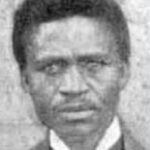RUWEJ a NKOND
- 3 Min Read
Ruwej a Nkond (who flourished in the 16th century) was a queen who ruled in the formative period of the Lunda state. She figures prominently in legends regarding the beginnings of the state, which was located in southern Zaire (now the Democratic Republic of the Congo), eastern Angola, and northern Zambia. Although oral tradition portrays Ruwej as a historical personage, modern scholarship emphasises the symbolic meaning in her story.
According to the Lunda oral record, Ruwej was the youngest daughter of Chief Nkond a Matit and his wife Rukcmbu. In contrast, the Cokwe (Chokwe), who originally lived in northeastern Angola, claim that Ruwej was the youngest daughter of Mwaket of Tumba.
Following the Lunda version, Ruwej succeeded her father because he disinherited his two sons, Chigud and Chiyam. After Chigud and Chiyam had rudely beaten their father, whom they accused of refusing them palm wine, Nkond a Matit designated Ruwej as the heir of the Rukan, the sacred bracelet symbolising royal power.
When Nkond a Matit died, Ruwej became queen over the Nkalanyi (upper Mbuji-Mayi) river region. She ruled from her capital Musumba, situated east of the Lulua River, about 250 km (150 mi) north of modern Dilolo.
As she was unmarried, the council of Lunda land chiefs proposed to marry her to one of their own number who lived northeast of Musumba. But the marriage did not take place, as Mwin Kanitshin would not renounce his own office, nor would he leave his residence for that of Queen Ruwej a Nkond.
In the end, she married a non-Lunda outsider, a Luba hunter named Chibind Yirung. While marriage to a local land chief would have symbolised continuity with past practices of government, Ruwej’s union with a Luba interloper represented innovative change. According to oral tradition, Ruwej’s choice of a husband angered Chigud and Chiyam, who left the Lunda homeland to establish new states. This event, thus, marks the beginning of Lunda expansion into Angola and Kasai.
According to Lunda custom, women are forbidden to keep the sacred royal bracelet during their menstrual period. When Ruwej entered her monthly period, she entrusted the bracelet to her husband, Chibind Yirung. This act greatly angered many Lunda, who then rebelled against Ruwej. The uprising was put down only with the help of Cokwe warriors from Angola. Because of this conflict, large numbers of Lunda chose to emigrate, rather than accept the new political situation.
According to the Lunda tradition, Ruwej a Nkond had no children by Chibind Yirung. Thus, he married another woman who gave birth to Yav a Yirung (Luseng), whose son Nawej became the first Mwant Yav (paramount chief). When she died, she was buried at the Kavadilongombe River. The chiefs then chose a new Ruwej from among the female descendants of the family of Nkond a Matit. This woman took the name “Swanamurund,” a political title which has perpetuated even to this day the memory of Ruwej a Nkond.
N’DUA SOLOL KANAMPUMB





